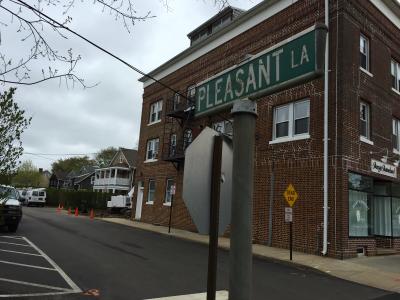Rise Up Against Un-Pleasant Lane

Pleasant Lane is to remain a two-way, dead-end street after East Hampton Village officials said last Thursday they would abandon an idea to make it partly one-way and open it up to the village’s long-term parking lot, which sits on the other side of a fence, a few trees, and a sidewalk at the end of the street.
Staunch opposition from several residents brought about the change of heart at last Thursday’s village board meeting, which was attended by about 20 people. The village had been considering making Pleasant Lane, which runs north-south off Newtown Lane near Railroad Avenue, a one-way street in the southbound direction heading toward the long-term lot. The proposal called for leaving the block a two-way street between Newtown Lane and the egress from the Suffolk County National Bank parking lot.
“This is a recipe for disaster,” Patrick Dellay, a resident of Pleasant Lane since January 1998, said. He said opening the block to the long-term parking lot would “utterly destroy the character of the neighborhood,” which he said already suffers from a difficult situation in which parking is only permitted along one side of the street, is not allowed overnight, and is often scooped up during the day by workers from nearby businesses and construction sites.
Francine Hanford, who has lived on Pleasant Lane most of her life, agreed with Mr. Dellay. “We have to jockey for parking spaces, and now we can’t park there overnight,” she said. “I can’t do anything, but everybody can take away from us. . . . It’s getting ridiculous. Leave our street alone.”
Matt Potz, a Pleasant Lane resident who works at Suffolk County National Bank, said if the street was opened up, the many pedestrians who walk on Pleasant Lane would have to dodge even more traffic. There are no sidewalks on the street.
“The kind of traffic you’re going to be introducing, the road was never meant to have,” Mr. Potz said. “It’s going to ruin the whole neighborhood. You’re going to have to change the name because it would be a cruel joke to call it ‘Pleasant Lane.’ I don’t think it’s safe.”
Others raised concerns about the removal of the trees at the end of the street, and the ability of two first responders who live thre to be able to get to the emergency services building in an efficient way. Opening the street would mean drivers would use it as a shortcut into the long-term parking lot, they said.
“We have certainly heard you,” Mayor Paul F. Rickenbach said, saying the idea would now be “off the table.” He then suggested prohibiting left turns from Pleasant Lane onto Newtown Lane either permanently or during the busy season.
“We’ve had some pedestrian accidents in that crosswalk that we’re trying to eliminate,” Richard Lawler, a board member, said. “It’s difficult to look left and right, integrate into traffic, and then keep your eye on the pedestrians.”
The suggestion was met with support from a few of the residents at the meeting, who also recommended more dead-end signs where the street begins. The village board made no formal decisions on these suggestions.
Also at last Thursday’s meeting, the village board gave Becky Molinaro, the village administrator, the green light to explore putting a charging station for electric vehicles in the long-term parking lot. It would be similar to one East Hampton Town installed at Town Hall late last year. The cost for charging would be similar, around $2.50 for a three-hour charge. The charging station would accept credit cards and could accommodate two vehicles at once.
The village board also voted, following a brief public hearing, to amend its town code to expedite permits for work done to houses to make them more accessible for elderly people or those with disabilities. The new law applies to “specific universal design features” in single-family homes, such as ramps, wider doors on ground floors, wheelchair-accessible bathrooms, stair lifts, and other adaptability elements.
